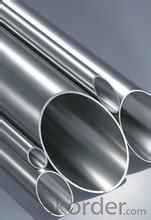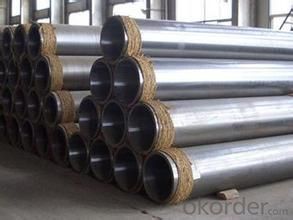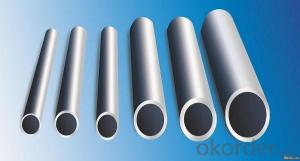Oil Gas Sewage Transport Usage Hot Rolled Stainless Steel Pipe
- Loading Port:
- Tianjin
- Payment Terms:
- TT OR LC
- Min Order Qty:
- 35 m.t.
- Supply Capability:
- 5000 m.t./month
OKorder Service Pledge
OKorder Financial Service
You Might Also Like
Item specifice
1.Structure of Hot Rolled Stainless Steel Pipe:
Seamless pipe is formed by drawing a solid billet over a piercing rod to create the hollow shell. As the manufacturing process does not include any welding, seamless pipes are perceived to be stronger and more reliable. Historically seamless pipe was regarded as withstanding pressure better than other types, and was often more easily available than welded pipe.
2.Main Features of the Hot Rolled Stainless Steel Pipe:
• High manufacturing accuracy
• High strength
• Small inertia resistance
• Strong heat dissipation ability
• Good visual effect
• Reasonable price
3.Hot Rolled Stainless Steel PipeSpecification:
Standard | GB, DIN, ASTM ASTM A106-2006, ASTM A53-2007 |
Grade | 10#-45#, 16Mn 10#, 20#, 45#, 16Mn |
Thickness | 8 - 33 mm |
Section Shape | Round |
Outer Diameter | 133 - 219 mm |
Place of Origin | Shandong, China (Mainland) |
Secondary Or Not | Non-secondary |
Application | Hydraulic Pipe |
Technique | Cold Drawn |
Certification | API |
Surface Treatment | factory state or painted black |
Special Pipe | API Pipe |
Alloy Or Not | Non-alloy |
Length | 5-12M |
Outer Diameter | 21.3-610mm |
Grade | 20#, 45#, Q345, API J55, API K55, API L80, API N80, API P110, A53B |
Standard | ASME, ASTM |
1) Material:20#(ASTM A 106/A53 GRB.API5LGRB,GB),45#,16Mn,10#.
2) Specification range:OD:21.3-610mm,WT:6-70mm,length:6-12m or according to the requirement of clients.
3) Excutive standards:GB,ASME API5L.ASTM A 106/A53,Despite of the above standards,we can also supply seamless steel pipe with standard of DIN,JIS,and so on,and also develop new products according to the requirements of our clients!
4) Surface:black lacquered,varnish coating or galvanized.
5) Ends:Beveled or square cut,plastic capped,painted.
6) Packing:bundles wrapped with strong steel strip,seaworthy packing.
4.Packaging & Delivery
Packaging Details: | seaworthy package,bundles wrapped with strong steel strip |
Delivery Detail: | 50-60days after received 30%TT or Original LC |
5.FAQ of Hot Rolled Stainless Steel Pipe:
How is the quality of your products?
Our products are manufactured strictly according to national and internaional standard, and we take a test on every pipe before delivered out. If you want see our quality certifications and all kinds of testing report, please just ask us for it.
Guaranteed: If products’ quality don’t accord to discription as we give or the promise before you place order, we promise 100% refund.
②How about price?
Yes, we are factory and be able to give you lowest price below market one, and we have a policy that “ for saving time and absolutely honest business attitude, we quote as lowest as possible for any customer, and discount can be given according to quantity”,if you like bargain and factory price is not low enough as you think, just don’t waste your time.Please trust the quotation we would give you, it is professional one.
③Why should you chose us?
Chose happens because of quality, then price, We can give you both.Additionally, we can also offer professional products inquiry, products knowledge train(for agents), smooth goods delivery, exellent customer solution proposals.Our service formula: good quality+good price+good service=customer’s trust
SGS test is available, customer inspection before shipping is welcome, third party inspection is no problem.
Any question, pls feel free to contact us !
6.Hot Rolled Stainless Steel Pipe Images:


7. Company Information:
CNBM International Corporation (CNBM International) is the most important trading platform of CNBM Group Corporation, a state-owned company under the direct supervision of State-owned Assets Supervision and Administration Commission of the State Council.
Since 2004, the trading volume of CNBM International has been doubled in 5 successive years owing to the support of superior corporations and effort of all staff. Meanwhile, we have established strategic partnerships with hundreds of domestic manufacturers and sound business relations with clients from over 120 countries. Currently, we have wholly-owned overseas subsidiaries and branches in 5 countries with a view to realize localization, which also represents an essential progress in our globalization target.
In line with the business, CNBM International launched E-business platform Okorder.com.Our goal is to transform CNBM International into the global leading brand in building materials industry within 3 to 5 years through innovation and reform, by strengthening the overall management of supply chain, developing and cultivating both domestic and overseas market, improving the procedure and information system, enhancing the ability to organize resources and to provide value-added services under a professional team and a learning organization.
- Q:What are the different types of stainless steel pipe supports?
- Various industries and applications commonly utilize several types of stainless steel pipe supports. These options include: 1. Adjustable pipe supports: These supports facilitate easy adjustment of pipe position or height. They often feature a threaded rod or telescoping design for accommodating different pipe sizes or installation requirements. 2. Pipe hangers: These supports suspend pipes from overhead structures. They typically consist of a metal bracket or clamp attached to a beam or structural element, along with a hanging rod or strap that bears the pipe's weight. 3. Pipe clamps: These supports secure pipes to walls, floors, or surfaces. They usually consist of a metal clamp wrapped around the pipe and affixed to the surface using screws or bolts. Pipe clamps can be adjustable or fixed, depending on the application. 4. Pipe saddles: These supports cradle or uphold pipes on horizontal surfaces. They generally consist of a U-shaped metal bracket or saddle attached to the surface, supplemented with a cushioning material like rubber or neoprene to prevent pipe damage. 5. Pipe guides: These supports guide or control pipe movement, particularly in situations where thermal expansion or contraction is a concern. They usually comprise a metal bracket or guide fixed to a structure, along with a sliding or rolling element that allows the pipe to move while maintaining alignment. Each specific type of stainless steel pipe support possesses distinct advantages and is designed to fulfill unique installation requirements. The selection of a support depends on factors such as pipe material, size, weight, and specific application needs.
- Q:What are the limitations of using stainless steel pipes?
- Some limitations of using stainless steel pipes include their higher cost compared to other materials, their susceptibility to corrosion in certain environments, and their lower thermal conductivity compared to materials like copper. Additionally, stainless steel pipes may be more difficult to cut and weld, and their strength and durability may vary depending on the specific grade of stainless steel used.
- Q:Can stainless steel pipes be electroplated?
- No, stainless steel pipes cannot be electroplated. Electroplating is a process by which a layer of metal is deposited onto a conductive surface using an electric current. However, stainless steel is already a corrosion-resistant material due to its composition of chromium, which forms a protective layer on its surface. Because of this, stainless steel pipes do not require electroplating as they already possess the desired properties of durability and resistance to corrosion.
- Q:Are stainless steel pipes suitable for extreme weather conditions?
- Yes, stainless steel pipes are highly suitable for extreme weather conditions. Stainless steel is known for its exceptional resistance to corrosion, making it ideal for withstanding harsh weather conditions such as extreme temperatures, heavy rain, and high humidity. Additionally, stainless steel pipes have excellent strength and durability, allowing them to withstand the impact of strong winds, storms, and other extreme weather events. Moreover, stainless steel is not affected by UV radiation, so it will not degrade or discolor when exposed to intense sunlight. Overall, stainless steel pipes are a reliable and long-lasting option for any application that requires resistance to extreme weather conditions.
- Q:What is the maximum pressure rating for stainless steel pipe fittings?
- The maximum pressure rating for stainless steel pipe fittings varies depending on several factors such as the material grade, size, and temperature. Generally, stainless steel pipe fittings can handle high-pressure applications due to their inherent strength and corrosion resistance. The pressure rating of these fittings can range from 150 psi (pounds per square inch) to as high as 10,000 psi, depending on the specific fitting and its intended use. It is essential to consult the manufacturer's documentation or industry standards such as ASME B16.11 or ASME B16.9 to determine the maximum pressure rating for a specific stainless steel pipe fitting. Additionally, it is crucial to consider other factors such as the type of sealing method used, compatibility with the fluid being conveyed, and any additional safety measures required in high-pressure systems.
- Q:Stainless steel why rust?
- Stainless steel surface adhesion of organic juice (such as vegetables, soup, sputum), oxygen in the water under the circumstances, a long time, organic acid, organic acid on the surface of metal corrosion.
- Q:Can stainless steel pipes be magnetized?
- Yes, stainless steel pipes can be magnetized if they contain a sufficient amount of ferromagnetic elements, such as iron, nickel, or cobalt. However, most stainless steel pipes are non-magnetic due to the low iron content in their composition.
- Q:What is the difference between 304N and 304LN stainless steel pipes?
- The main difference between 304N and 304LN stainless steel pipes lies in their chemical composition and the presence of nitrogen. 304N stainless steel pipes have a higher nitrogen content compared to 304LN stainless steel pipes. Nitrogen enhances the strength and corrosion resistance of stainless steel, making it more suitable for applications in high-stress environments or corrosive conditions. The increased nitrogen content in 304N stainless steel pipes improves their overall performance in terms of strength, hardness, and resistance to pitting and crevice corrosion. On the other hand, 304LN stainless steel pipes have a lower nitrogen content but still possess excellent corrosion resistance properties. These pipes are specifically designed for low-temperature applications where toughness is required. The lower nitrogen content in 304LN stainless steel pipes helps maintain good weldability and formability, making them suitable for various fabrication processes. In summary, the difference between 304N and 304LN stainless steel pipes lies in the nitrogen content, which affects their strength, corrosion resistance, and suitability for different applications.
- Q:What is the difference between seamless and extruded stainless steel pipes?
- Seamless and extruded stainless steel pipes are utilized in various industries and applications, but they differ in several ways. 1. Manufacturing Process: The manufacturing process distinguishes seamless and extruded stainless steel pipes. Seamless pipes are formed through hot rolling or hot extrusion, where a heated cylindrical billet is pushed or pulled through a die to create a pipe without any seams. In contrast, extruded pipes are made using cold extrusion, forcing a solid stainless steel billet through a die to achieve the desired shape and size. 2. Seamless Nature: Seamless pipes, as their name suggests, lack any seams or welds along their length. This attribute enhances their strength and structural integrity. In contrast, extruded pipes may display visible seams or welds, potentially compromising the overall structure. 3. Sizes and Dimensions: Seamless pipes offer a wider range of sizes and dimensions compared to extruded pipes. This is due to the flexibility provided by the hot rolling process, which allows for greater shaping and forming capabilities. Extruded pipes, however, are limited in their size range and are typically used for smaller diameter applications. 4. Surface Finish: Seamless pipes generally boast a smooth and polished surface finish, making them suitable for applications where aesthetics are important, such as architectural structures or decorative elements. Conversely, the manufacturing process of extruded pipes can result in a rougher surface finish, making them more appropriate for industrial or structural applications where appearance is less critical. 5. Cost: In general, seamless pipes are more expensive than extruded pipes due to the complexity of the manufacturing process. The hot rolling method necessitates specialized equipment and a higher level of expertise, increasing production costs. On the other hand, extruded pipes are more cost-effective as they are produced through a simpler cold extrusion process. In conclusion, the differences between seamless and extruded stainless steel pipes encompass their manufacturing process, seamless nature, size range, surface finish, and cost. The choice between the two will depend on the specific requirements of the application at hand.
- Q:Can stainless steel pipes be used for wastewater treatment plants?
- Yes, stainless steel pipes can be used for wastewater treatment plants. Stainless steel is highly resistant to corrosion and can withstand the harsh and corrosive environment of wastewater treatment plants. It is a durable and reliable material that can effectively transport and handle wastewater without degradation or contamination.
1. Manufacturer Overview |
|
|---|---|
| Location | |
| Year Established | |
| Annual Output Value | |
| Main Markets | |
| Company Certifications | |
2. Manufacturer Certificates |
|
|---|---|
| a) Certification Name | |
| Range | |
| Reference | |
| Validity Period | |
3. Manufacturer Capability |
|
|---|---|
| a)Trade Capacity | |
| Nearest Port | |
| Export Percentage | |
| No.of Employees in Trade Department | |
| Language Spoken: | |
| b)Factory Information | |
| Factory Size: | |
| No. of Production Lines | |
| Contract Manufacturing | |
| Product Price Range | |
Send your message to us
Oil Gas Sewage Transport Usage Hot Rolled Stainless Steel Pipe
- Loading Port:
- Tianjin
- Payment Terms:
- TT OR LC
- Min Order Qty:
- 35 m.t.
- Supply Capability:
- 5000 m.t./month
OKorder Service Pledge
OKorder Financial Service
Similar products
New products
Hot products
Related keywords




























